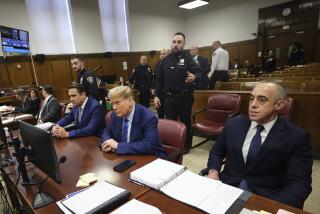NEWS ANALYSIS : Jurors Assert Rights--but at What Cost?
- Share via
As the O.J. Simpson jurors went the way of penniless janitors and millionaire ballplayers before them--staging a high-impact, controversial strike--they may have landed a blow for beleaguered jurors everywhere, but they also brought the trial perilously close to collapse.
“The question of the day is: Are we now at meltdown?” mused criminal defense lawyer Gigi Gordon.
Superior Court Judge Lance A. Ito now faces a narrow and unappetizing set of options, including declaring a mistrial, attempting to coax the apparently deeply divided jury into cohesion, hiring a psychologist to help mend the jury rifts, or perhaps ending the panel’s sequestration.
If Ito declared a mistrial, Simpson’s attorneys undoubtedly would contend that their client cannot be retried because of the constitutional prohibition against double jeopardy, said USC law professor Erwin Chemerinsky. He noted, however, that the standard for declaring a mistrial in California is very difficult to meet: It requires both a showing that a fair verdict cannot be obtained and that the problem is incurable.
On the other hand, if the trial moves forward without some major change in relations among the apparently deeply divided jury, the prospects of a hung jury are substantial. “One implication of this juror revolt is how it confirms the low probability that these 12 jurors will ever agree to a verdict,” said UCLA law professor Peter Arenella.
Chemerinsky also said that even if the case continued to conclusion and a guilty verdict, the number of issues on which Simpson might appeal is growing steadily. “However Ito handles the situation with the jury, there could be an argument that he erred. Still, saying that there are issues for an appeal doesn’t mean there are winning issues,” Chemerinsky said.
Regardless of the outcome, legal experts called the situation unprecedented. “This is sui generis--one of a kind--like everything else in the Simpson case,” said retired Superior Court Judge George Dell.
“This is amazing. When the jury refuses to participate, the jury, not the judge, is controlling the case,” said Loyola Law School professor Laurie Levenson.
University of San Francisco law professor Sharon A. Meadows said the latest bizarre development was a sign that “even though the jurors are sequestered, it seems that they are fully participating in the case as theater.”
Some, among them Wyoming trial lawyer Gerry Spence, applauded the rebellion: “Here is a jury that has finally recognized its own power. They are not simply minions of the judge who are paid $5 a day who can be thrown in jail if they don’t do what Ito wants. They are dignified people who have the ultimate power in the case and may set a model for jurors across the country who sit in courtrooms like beaten dogs.”
Robert Gordon, a psychologist and lawyer who studies juries at the Wilmington Institute of Trial Science in Dallas, also expressed admiration at the revolt.
“The mutiny is their assertion of dignity and their right to disagree with the court,” he said. “It’s an expression of their frustration with their fishbowl experience. They feel they are being put on trial instead of O.J. Simpson. And they are lodging a protest that is uniquely American--they’re protesting a ruling of a government official in a nonviolent way.”
Also cheering for the jury was state Sen. Tom Hayden (D-Santa Monica), himself a defendant in the celebrated 1969-70 Chicago 7 conspiracy trial. “By definition, these jurors are not people who have spent their lives rebelling or they wouldn’t be on the jury,” Hayden said. “They don’t belong to activist organizations or they wouldn’t be on the jury. So if they’re doing this, it’s definite evidence that the system has suffocated them. It’s so suffocated such a humble group of people that they have adopted confrontational tactics.”
But one of Ito’s colleagues expressed horror at the jurors’ actions, saying it set a terrible precedent of “jurors unionizing and failing to perform their civic duty.”
Still, the veteran jurist said the revolt came as no surprise. “The jurors have seen everyone else in the courtroom walk all over Ito, so they figure they can do it themselves,” said the judge, who spoke on condition of anonymity.
Also unsurprised was Theodora J. Replogle, a member of the jury that was sequestered for 2 1/2 weeks during the 1989 trial of Orange County serial murderer Randy Steven Kraft.
At first, she said, jurors are likely to shrink from confronting the black-robed judge or gun-toting sheriff’s deputies who are supervising them. But, as a case progresses, jurors see the court officers’ foibles and realize that “they’re just people, too.” Once they are no longer intimidated, the jurors become determined that they are “not going to be pushed around. The longer you’re there . . . you just become more assertive,” Replogle said.
Several analysts said Ito may have to end the pressure cooker sequestration if he is to have any chance of getting a verdict.
“The evils that have arisen are the inevitable result of having a jury sequestered for a long time in a high-profile case,” said University of Texas law professor Michael E. Tigar. “In long trials, sequestered juries are a very bad idea. The pressure creates conflicts among jurors and troubled relationships between jurors and bailiffs that inevitably create problems.”
Stephen Kay, one of the prosecutors in the lengthy Manson family murder trial in 1970, said ending the sequestration would be preferable to declaring a mistrial.
“Still,” said Kay, now chief deputy district attorney in Compton, “the problem is there is so much pervasive publicity with innuendoes and rumors floating around. I don’t know that the jurors could escape that. I don’t know if they could just focus on what’s going on in court.”
Amid all the confusion and acrimony, Kay said he was “heartened” that the protest appears to involve African American and white jurors. “With all of this confusion and acrimony, it’s a good sign that it’s not a complete racial division. There may be some hope for getting the jury together in the end.”
Still, Ito needs to move quickly to forge both short-term and long-term solutions if he is going to salvage the trial, analysts said.
“First, the judge has to find a way to placate all the jurors with regard to the sheriffs,” Chemerinsky said. “The longer-term goal is keeping the jury from being irreparably split. That is a harder thing to do.”
Nonetheless, Chemerinsky said “Ito will fight hard to keep this jury together and keep this trial going.”
Among the primary reasons, Chemerinsky said, is that “even assuming that there would be a second trial--by reason of a mistrial or a hung jury--there’s no reason to believe we wouldn’t encounter the same problems all over again.”
Levenson said an angry and frustrated Ito might be tempted to threaten the jurors with a contempt citation, but that would be unwise. “I don’t think bullying is going to work. He can threaten them all he wants, but they have the power to decide whether this case will have a verdict.”
But she stressed that the precise course is unclear because Ito is moving through uncharted waters. “There’s no manual for dealing with boycotting jurors,” Levenson said.
Both Robert Gordon and Houston-based jury consultant Robert B. Hirschhorn went so far as to suggest that Ito needs to appoint a counselor or psychologist for the jury.
“This jury needs something like marriage counseling because this marriage is heading toward divorce,” Hirschhorn said.
Gordon said he interpreted the rebellion as a “plea for help,” and urged Ito to appoint a psychologist to help the jurors work through their “excruciating stress.”
*
Indeed, Friday’s developments are perhaps the strongest indication yet of “the psychological delicacy of a sequestered jury,” said Southwestern University law professor Karen Smith.
“I think, without knowing all the factual details, that Judge Ito regrets that he did not inform the jury in sufficient detail before he replaced three of the deputies that had previously been guarding them. After all, you would never replace a child-care attendant for your child without telling the child. That’s what’s jarring to at least some of the jurors. It’s like hearing ‘Nanny’s gone.’ ”
More to Read
Sign up for Essential California
The most important California stories and recommendations in your inbox every morning.
You may occasionally receive promotional content from the Los Angeles Times.













